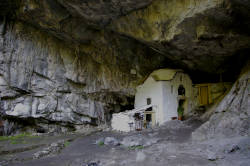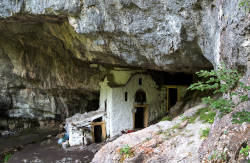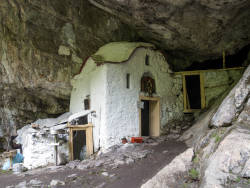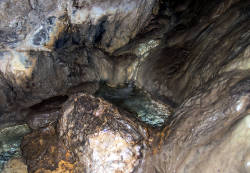Σπήλαιο Αγίου Διονυσίου
Spílaio Agíou Dionysíou - Cave of Agios Dionysios
Useful Information


| Location: |
Άγιο σπήλαιο Holy Cave of Agios Dionysios, Enipeas gorge, Mt Olympus.
(40.094161, 22.438017) |
| Open: |
no restrictions. [2021] |
| Fee: |
free. [2021] |
| Classification: |
 Cave Church Cave Church
|
| Light: | bring torch |
| Dimension: | |
| Guided tours: | self guided |
| Photography: | allowed |
| Accessibility: | no |
| Bibliography: | |
| Address: | Cave of Agios Dionysios, Litochoro 602 00. |
| As far as we know this information was accurate when it was published (see years in brackets), but may have changed since then. Please check rates and details directly with the companies in question if you need more recent info. |
|
History
| 1542 | monastery built. |
| 1943 | monastery destroyed by the Germans. |
Description


Σπήλαιο Αγίου Διονυσίου (Cave of Agios Dionysios) is located in the Enipeas gorge on Mount Olympus, only 800 m downstream from the monastery Αγίου Διονυσίου εν Ολύμπω (Agios Dionysios in Olympus). The monastery is accessible by a paved road, which actually leads from Litochoro to the foot of Mt. Olympus. At the end of the road is the mountain lodge Καταφύγιο Πριόνια (Prionia Shelter), which is the starting point for ascending Mt. Olympus. The turnoff to the monastery is only 2 km before the end of the road. From the car park at the monastery it’s about a twenty-minute walk to the chapel of Saint Dionysios.
The small chapel was built under an overhanging rock just above a spring. The chapel consists of a small devotional space where the saint celebrated the sacred liturgy during his time as a hermit and a small shed which served as him as a place to sleep. Some think his well has healing powers. He was the founder of the nearby monastery, and his right hand is venerated there as a relic.
Dionysios was born in the last years of the 15th century in the village of Slatina in Thessaly. Some time after their death he went to the Monastery of the Transfiguration at Meteora. After some time as a monk he heard about the hesychast life, ascesis and prayer of the monks of Athos. He went to Karyes, the capital of the Athonite community. But when he asked to be received into the brotherhood, he was sent back until he reached the required age. Finally he was accepted and soon he was ordained deacon and then priest. But he left the Monastery of Karakallou to live as a hermit nearby. The many chestnut trees which grew there enabled him to live free from care about food.
Then he made a pilgrimage to the Holy Land. He stopped at Iconium for some time, where the ageing Metropolitan wanted him to be his successor. But he went to the holy places and returned to Mount Athos.
He started to enlarge a small chapel all by himself. Many visitors came to receive his blessing. A brigand observed this and decided to waylay and murder Dionysios. But his eyes were darkened so that he did not see Dionysios. He went to his cell intending to ransack it thoroughly. But there, he met Dionysios, fell at his feet in tears, confessed his evil intention and eventually became a monk.
After seven years, the monks of Philotheou asked him to become their Abbot. He accepted and soon the monastery flourished. But some Bulgarian monks, resentful at losing their influence in the Monastery, plotted to kill him. He was warned and fled with some of the community to the Skete of Beroea. There he rebuilt the Church of Saint John the Forerunner, and reorganized the monastery according to the tradition of the Holy Mountain. But after some time the bishop’s throne of Beroea became vacant, and the people asked him to become their new bishop. So he fled to a secluded abode at the foot of Mount Olympus.
He lived there for a while as a hermit, and was joined by disciples and began the construction of a Monastery dedicated to the Holy Trinity. The Turkish governor of the district, angered by this unauthorized foundation, decided to arrest the Saint and his community. Dionysios was warned and fled with his disciples to Mount Pilion, where he founded the Monastery of the Holy Trinity of Sourvia. But God’s wrath descended on Olympus, and the villages suffered cruelly from gales and then from hail. The country folk went to the governor and persuaded him to recall Dionysios and his disciples. He granted them leave and the license to build their church and monastery. Dionysios returned to Olympus and lived in a cave, which he called the Cave of Golgotha. He and his brethren adopted a threefold pattern of life: silent seclusion, building work, and care of the poor and teaching of the people.
One day he realized that the time of his departure from this world had come. He gathered some of his disciples in the cave where he had been living, and exhorted them to persevere with faith in their way of life according to the tradition of the Holy Mountain. He died on 23 January 1541, while making his prayer for them to the Lord.
- See also
 Search DuckDuckGo for "Cave of Agios Dionysios"
Search DuckDuckGo for "Cave of Agios Dionysios" Google Earth Placemark
Google Earth Placemark Agios Dionysios Monastery, Olympus - Wikipedia (visited: 13-APR-2021)
Agios Dionysios Monastery, Olympus - Wikipedia (visited: 13-APR-2021) Saint Dionysios of Olympus (+1541) (visited: 13-APR-2021)
Saint Dionysios of Olympus (+1541) (visited: 13-APR-2021) Olympus Mountain - Ursa Minor (visited: 14-APR-2021)
Olympus Mountain - Ursa Minor (visited: 14-APR-2021) Monasteries and Churces (visited: 25-MAR-2022)
Monasteries and Churces (visited: 25-MAR-2022) Hiking in Greece on the Mythical Greek Mountain of Mount Olympus (visited: 25-MAR-2022)
Hiking in Greece on the Mythical Greek Mountain of Mount Olympus (visited: 25-MAR-2022)
 Index
Index Topics
Topics Hierarchical
Hierarchical Countries
Countries Maps
Maps